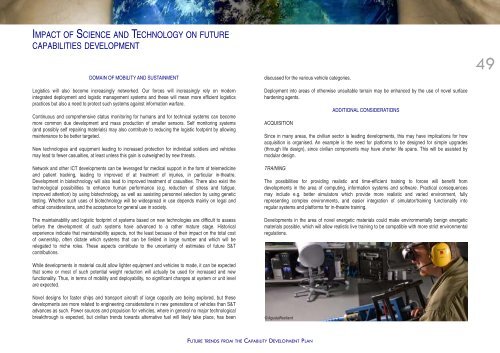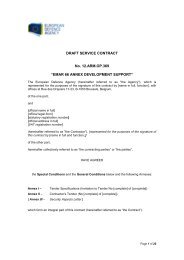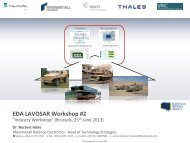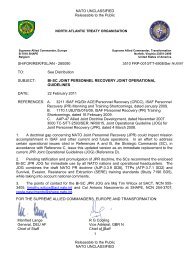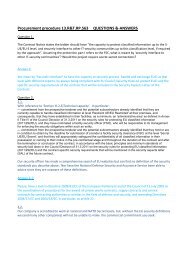capability development plan - European Defence Agency - Europa
capability development plan - European Defence Agency - Europa
capability development plan - European Defence Agency - Europa
Create successful ePaper yourself
Turn your PDF publications into a flip-book with our unique Google optimized e-Paper software.
IMPACT OF SCIENCE AND TECHNOLOGY ON FUTURE<br />
CAPABILITIES DEVELOPMENT<br />
DOMAIN OF MOBILITY AND SUSTAINMENT<br />
Logistics will also become increasingly networked. Our forces will increasingly rely on modern<br />
integrated deployment and logistic management systems and these will mean more efficient logistics<br />
practices but also a need to protect such systems against information warfare.<br />
Continuous and comprehensive status monitoring for humans and for technical systems can become<br />
more common due <strong>development</strong> and mass production of smaller sensors. Self monitoring systems<br />
(and possibly self repairing materials) may also contribute to reducing the logistic footprint by allowing<br />
maintenance to be better targeted.<br />
New technologies and equipment leading to increased protection for individual soldiers and vehicles<br />
may lead to fewer casualties, at least unless this gain is outweighed by new threats.<br />
Network and other ICT <strong>development</strong>s can be leveraged for medical support in the form of telemedicine<br />
and patient tracking, leading to improved of at treatment of injuries, in particular in-theatre.<br />
Development in biotechnology will also lead to improved treatment of casualties. There also exist the<br />
technological possibilities to enhance human performance (e.g. reduction of stress and fatigue,<br />
improved attention) by using biotechnology, as well as assisting personnel selection by using genetic<br />
testing. Whether such uses of biotechnology will be widespread in use depends mainly on legal and<br />
ethical considerations, and the acceptance for general use in society.<br />
The maintainability and logistic footprint of systems based on new technologies are difficult to assess<br />
before the <strong>development</strong> of such systems have advanced to a rather mature stage. Historical<br />
experience indicate that maintainability aspects, not the least because of their impact on the total cost<br />
of ownership, often dictate which systems that can be fielded in large number and which will be<br />
relegated to niche roles. These aspects contribute to the uncertainty of estimates of future S&T<br />
contributions.<br />
While <strong>development</strong>s in material could allow lighter equipment and vehicles to made, it can be expected<br />
that some or most of such potential weight reduction will actually be used for increased and new<br />
functionality. Thus, in terms of mobility and deployability, no significant changes at system or unit level<br />
are expected.<br />
Novel designs for faster ships and transport aircraft of large capacity are being explored, but these<br />
<strong>development</strong>s are more related to engineering considerations in new generations of vehicles than S&T<br />
advances as such. Power sources and propulsion for vehicles, where in general no major technological<br />
breakthrough is expected, but civilian trends towards alternative fuel will likely take place, has been<br />
discussed for the various vehicle categories.<br />
Deployment into areas of otherwise unsuitable terrain may be enhanced by the use of novel surface<br />
hardening agents.<br />
ACQUISITION<br />
ADDITIONAL CONSIDERATIONS<br />
Since in many areas, the civilian sector is leading <strong>development</strong>s, this may have implications for how<br />
acquisition is organised. An example is the need for platforms to be designed for simple upgrades<br />
(through life design), since civilian components may have shorter life spans. This will be assisted by<br />
modular design.<br />
TRAINING<br />
The possibilities for providing realistic and time-efficient training to forces will benefit from<br />
<strong>development</strong>s in the area of computing, information systems and software. Practical consequences<br />
may include e.g. better simulators which provide more realistic and varied environment, fully<br />
representing complex environments, and easier integration of simulator/training functionality into<br />
regular systems and platforms for in-theatre training.<br />
Developments in the area of novel energetic materials could make environmentally benign energetic<br />
materials possible, which will allow realistic live training to be compatible with more strict environmental<br />
regulations.<br />
© AgustaWestland<br />
49<br />
FUTURE TRENDS FROM THE CAPABILITY DEVELOPMENT PLAN


